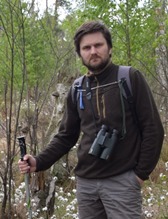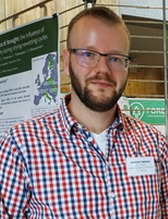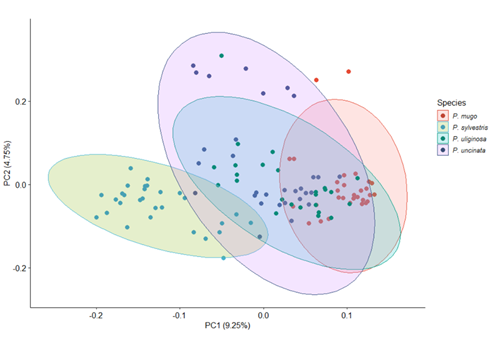
PhD Przemysław Kurek

- Plant-animal interactions, including seed dispersal and ecosystem engineering with European badger as an example
- Forest ecology with special attention to plant-soil interactions
- Basic faunistic and floristic investigations
- 2016-do dziś – adiunkt w Zakładzie Ekologii Roślin i Ochrony Środowiska na Wydziale Biologii Uniwersytetu im. Mickiewicza w Poznaniu
- 2013-2016 – adiunkt w Zakładzie Ekologii Instytutu Botaniki Polskiej Akademii Nauk w Krakowie
- Praca doktorska – 2012, „Depozycja nasion a rozmieszczenie endozoochorycznych drzew i krzewów rozprzestrzenianych przez ssaki drapieżne”, Instytut Botaniki PAN w Krakowie
- Praca magisterska – 2008, „Ekologia żerowania dzięcioła średniego Dendrocopos medius w okresie wiosennym w Puszczy Niepołomickiej”, Wydział Leśny UR w Krakowie
- Ekologia
- Ekologia i ochrona ekosystemów leśnych
- Szata roślinna gór na przykładzie Babiej Góry
- Gleboznawstwo i biologia gleby
Artykuły z IF
Piechnik Ł., Łabiszak B., Cieślak E., Szczepański S., Kurek P., Novikov A., Rosati L., Dönmez A.A., Dering M., Wójcik T., Wiatrowska B., Żywiec M., Wachowiak W. 2025. Genetic and biometric patterns of rangewide divergence of iconic, Neogene relic broadleaved shrub species Staphylea pinnata L. – post-glacial expansion and human impact. Vegetation History and Archaeobotany, 1-15.
Kapusta P., Wiśniewska O., Dmowska E., Kurek P. 2024. Effects of biopedturbation by European badger Meles meles on the forest soil food web persist for years as revealed by nematode indicators. App. Soil Ecol. 206: 105871. https://doi.org/10.1016/j.apsoil.2025.105871.
Ważna A., Nowakowski K., Kurek P., Ciepliński M., Cichocki J. 2024. Use of European badger setts by invasive raccoons and other mesocarnivores in western Poland. Mammal Research 1-6. https://doi.org/10.1007/s13364-024-00770-1.
Wiatrowska B., Kurek P., Rutkowski T., Sienkiewicz P., Napierała A., Błoszyk J. 2024. Consequences of Spiraea tomentosa invasion in Uropodina mite (Acari: Mesostigmata) communities in wet meadows. Experimental and Applied Acarology 93: 609-626.
Kurek P., Wiatrowska B., Piechnik Ł., Holeksa J. 2024. Phenological gap in fruiting period and dispersal of seeds from alien fleshy-fruited plants by medium-sized carnivores in temperate forests of Central Europe. Neobiota 93: 321–337. https://doi.org/10.3897/neobiota.93.128008.
Kurek P., Wiatrowska B., Ważna A., Vink H. 2024. Setts of European badger Meles meles in open habitats: trend or exception? Mammal Review https://doi.org/10.1111/mam.12373.
Wróbel A., Kurek P., Bobiec A. 2024. The hidden truth: unusual acorn caching sites by Eurasian Jays (Garrulus glandarius L.) re-examined. Journal of Ornithology https://doi.org/10.1007/s10336-024-02181-0.
González-Varo J. P., Albrecht J., Arroyo J. M., Bueno R. S., Burgos T., Escribano-Ávila G., Farwig N., García D., Illera J. C., Jordano P., Kurek P., Rösner S., Virgós E., Sutherland W. J. 2023. Frugivore-mediated seed dispersal in fragmented landscapes: Compositional and functional turnover from forest to matrix. PNAS 120, 44: e2302440120.
Niedbała W., Maziarz M., Hebda G., Rutkowski T., Napierała A., Kurek P., Zacharyasiewicz M., Broughton R. K., Błoszyk J. 2023. Songbird nests on the ground as islands of diversity of ptyctimous mites (Acari: Oribatida) in the primeval Białowieża Forest (Poland). Exp. App. Acarol. https://doi.org/10.1007/s10493-023-00800-8.
Wiatrowska B., Kurek P., Moroń D., Celary W., Chrzanowski A., Trzciński P., Piechnik Ł. 2023. Linear scaling – negative effects of invasive Spiraea tomentosa (Rosaceae) on wetland plants and pollinator communities. Neobiota 81: 63-90 doi: 10.3897/neobiota.81.95849.
Kurek P., Dobrowolska D., Wiatrowska B., Seget B., Piechnik Ł. 2023. Low rate of pre-dispersal acorn predation by Eurasian Jays Garrulus glandarius during non-mast years. Acta Ornithologica 57: 211-215.
Wróbel A., Kurek P., Bogdziewicz M., Dobrowolska D., Zwolak R. 2022. Avian dispersal of an invasive oak is modulated by acorn traits and the presence of a native oak. Forest Ecology and Management 505: 119866.
Nowakowski K., Ważna A., Kurek P., Cichocki J., Bojarski J., Gabryś G. 2022. Long arm of motorway – the impact of fenced road on the mortality of European badgers. Environ. Manage. doi: 10.1007/s00267-021-01570-y.
Zacharyasiewicz M., Napierała A., Kurek P., Grossmann K., Błoszyk J. 2021. Is biodiversity of Uropodina mites (Acari: Parasitiformes) inhabiting dead wood dependent on the tree species? Diversity 13: 609. https://doi.org/10.3390/d13120609.
Kurek P., Piechnik Ł., Wiatrowska B., Ważna A., Nowakowski K., Pardavila X., Cichocki J., Seget B. 2022. Badger Meles meles as ecosystem engineer and its legal status in Europe. Animals 12: 898. https://doi.org/10.3390/ani12070898.
Piechnik Ł., Holeksa J., Ledwoń M., Kurek P., Szarek-Łukaszewska G., Żywiec M. 2022. Stand composition, tree-related microhabitats and birds – a network of relationships in a managed forest. Forests 13(1), 103. https://doi.org/10.3390/f13010103.
Holeksa J., Żywiec M., Bogdziewicz M., Kurek P., Milne-Rostkowska F., Piechnik Ł., Seget B. 2021. Microsite-specific 25-year mortality of Norway spruce saplings. Forest Ecology and Management 498: 119572.
González-Varo J. P., Rumeu B., Albrecht J., Arroyo J. M., Bueno R. S., Burgos T., da Silva L. P., Escribano-Ávila G., Farwig N., García D., Heleno R. H., Illera J. C., Jordano P., Kurek P., Simmons B. I., Virgós E., Sutherland W. J., Traveset A. 2021. Limited potential for bird migration to disperse plants to cooler latitudes. Nature doi.org/10.1038/s41586-021-03665-2
Dobrowolska D., Kurek P., Olszowska G., Bolibok L. 2021. Effects of stand features and soil enzyme activity on spontaneous pedunculate oak regeneration in Scots pine dominated stands – implication for forest management. Forest Ecosystems 8,43. doi.org/10.1186/s40663-021-00317-9.
Myczko Ł., Kurek P., Tryjanowski P., Wiatrowska B., Jankowiak Ł., Mielczarek Ł., Sienkiewicz P., Rutkowski T., Ondrejková A. 2021. Where to overwinter: Burrows of medium-sized carnivores as winter places for invertebrates in temperate environment. Ecological Entomology doi: 10.1111/een.13062.
Wróbel A., Kurek P., Dobrowolska D. 2021. Acorn storage in tree cavities by Eurasian Jay (Garrulus glandarius L.). Journal of Ornithology. doi.org/10.1007/s10336-021-01892-y
Artykuły bez IF
Kurek P., Wiatrowska B. 2024. Carex tomentosa. W: Wójcik et al. Nowe stanowiska roślin naczyniowych Polski, 5. Wiadomości Botaniczne 68: 195663. DOI: 10.5586/wb/195663.
Kurek P., Wiatrowska B., Święciak T., Piechnik Ł., Skowron B. 2024. Nowe stanowisko Goodyera repens (L.) R. Br. (Orchidaceae) w borze sosnowym na Wyżynie Częstochowskiej. Fragm. Flor. Geobot. Pol. 29: 211-216.
Wiatrowska B., Kurek P. 2023.Lycopodiella inundata (L.) Holub. W: Wójcik et al. Nowe stanowiska roślin naczyniowych Polski, 4. Wiadomości Botaniczne DOI: 10.5586/wb/174423.
Kurek P., Wiatrowska B. 2023. New record of Rangia cuneata (Mollusca: Bivalvia: Mactridae) on southern coast of Baltic Sea (N Poland). European Journal of Ecology 9, 2: 6-8.
Kurek P., Wiatrowska B., Tyburski Ł., Marczak D. 2022. Vascular flora changes in canopy gaps caused by wind. Biodiversity: Research and Conservation 66: 1-10.
Piechnik Ł., Kurek P., Wójcik T. 2021. Distribution of the European bladdernut Staphylea pinnata (Staphyleaceae) in Poland. Plant and Fungal Systematics 66(2): 166-183.
Publikacje popularnonaukowe
Piechnik Ł., Kurek P. 2022. Jan Kalinowski – badacz fauny Peru. Wszechświat 123: 158-162.
Kurek P. 2021. Borsuk Meles meles. Zeszyty z Płazy 4: 50-56.
Wybrane publikacje
Ważna, A., Nowakowski, K., Kurek, P., Ciepliński, M., & Cichocki, J. (2024). Use of European badger setts by invasive raccoons and other mesocarnivores in western Poland. Mammal Research 1-6. https://doi.org/10.1007/s13364-024-00770-1.
Wiatrowska B., Kurek P., Rutkowski T., Sienkiewicz P., Napierała A., Błoszyk J. 2024. Consequences of Spiraea tomentosa invasion in Uropodina mite (Acari: Mesostigmata) communities in wet meadows. Experimental and Applied Acarology 93: 609-626.
Kurek P., Wiatrowska B., Piechnik Ł., Holeksa J. 2024. Phenological gap in fruiting period and dispersal of seeds from alien fleshy-fruited plants by medium-sized carnivores in temperate forests of Central Europe. Neobiota 93: 321–337. https://doi.org/10.3897/neobiota.93.128008.
Kurek P., Wiatrowska B., Ważna A., Vink H. 2024. Setts of European badger Meles meles in open habitats: trend or exception? Mammal Review https://doi.org/10.1111/mam.12373.
González-Varo J. P., Albrecht J., Arroyo J. M., Bueno R. S., Burgos T., Escribano-Ávila G., Farwig N., García D., Illera J. C., Jordano P., Kurek P., Rösner S., Virgós E., Sutherland W. J. 2023. Frugivore-mediated seed dispersal in fragmented landscapes: Compositional and functional turnover from forest to matrix. PNAS 120, 44: e2302440120.
Wiatrowska B., Kurek P., Moroń D., Celary W., Chrzanowski A., Trzciński P., Piechnik Ł. 2023. Linear scaling – negative effects of invasive Spiraea tomentosa (Rosaceae) on wetland plants and pollinator communities. Neobiota 81: 63-90 doi: 10.3897/neobiota.81.95849.
Kurek P., Dobrowolska D., Wiatrowska B., Seget B., Piechnik Ł. 2023. Low rate of pre-dispersal acorn predation by Eurasian Jays Garrulus glandarius during non-mast years. Acta Ornithologica 57: 211-215.
Kurek P., Piechnik Ł., Wiatrowska B., Ważna A., Nowakowski K., Pardavila X., Cichocki J., Seget B. 2022. Badger Meles meles as ecosystem engineer and its legal status in Europe. Animals 12: 898. https://doi.org/10.3390/ani12070898.
Holeksa J., Żywiec M., Bogdziewicz M., Kurek P., Milne-Rostkowska F., Piechnik Ł., Seget B. 2021. Microsite-specific 25-year mortality of Norway spruce saplings. Forest Ecology and Management 498: 119572.
González-Varo J. P., Rumeu B., Albrecht J., Arroyo J. M., Bueno R. S., Burgos T., da Silva L. P., Escribano-Ávila G., Farwig N., García D., Heleno R. H., Illera J. C., Jordano P., Kurek P., Simmons B. I., Virgós E., Sutherland W. J., Traveset A. 2021. Limited potential for bird migration to disperse plants to cooler latitudes. Nature doi.org/10.1038/s41586-021-03665-2
Kurek P. 2019. Topsoil mixing or fertilization? Forest flora changes in the vicinity of badgers’ (Meles meles L.) setts and latrines. Plant and Soil 437: 327-340.
Kurek P., Dobrowolska D., Wiatrowska B. 2018. Dispersal distance and burial mode of acorns in Eurasian Jays Garrulus glandarius in European temperate forests. Acta Ornithologica 53: 155-162.
Kurek P., Dobrowolska D., Wiatrowska B., Dylewski Ł. 2018. What if Eurasian jay Garrulus glandarius would larder acorns instead of scatter them? iForest 11: 685-689.







